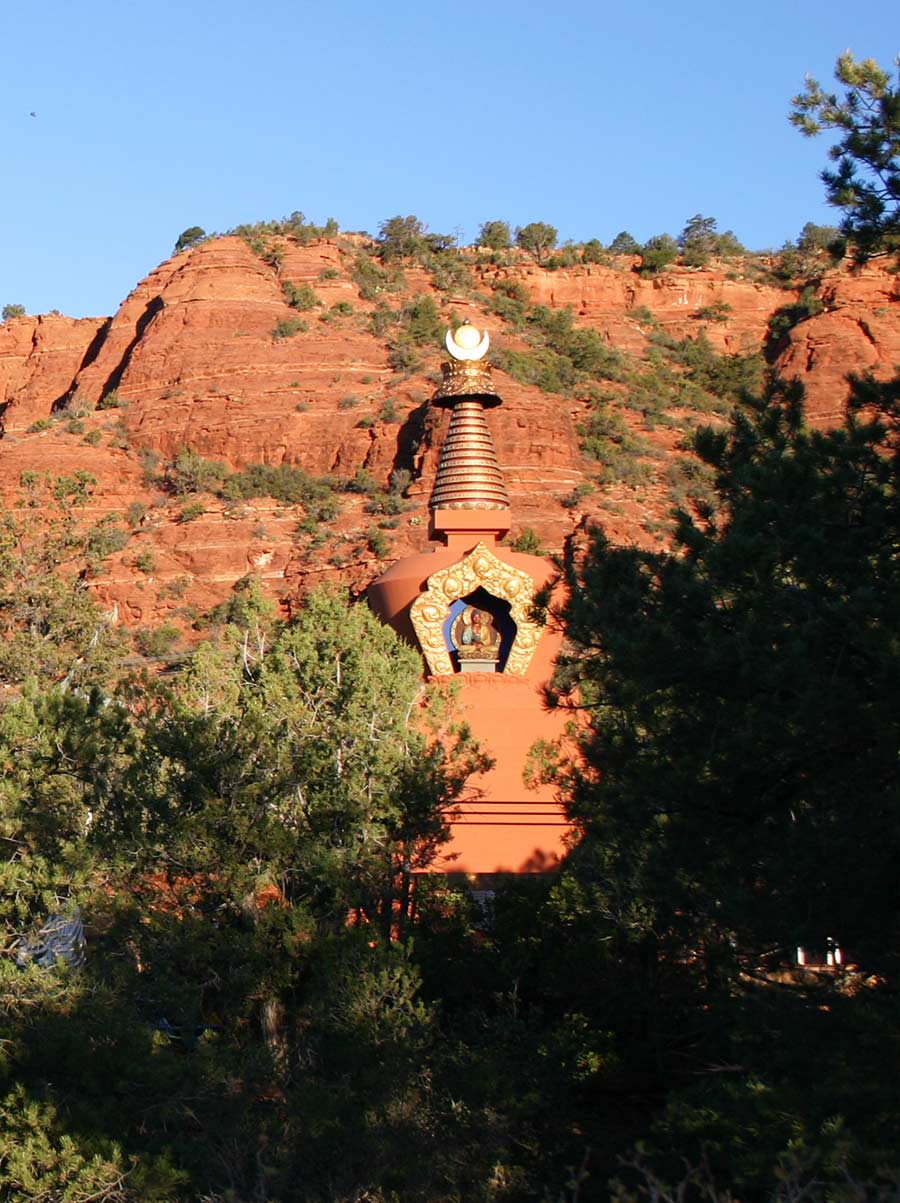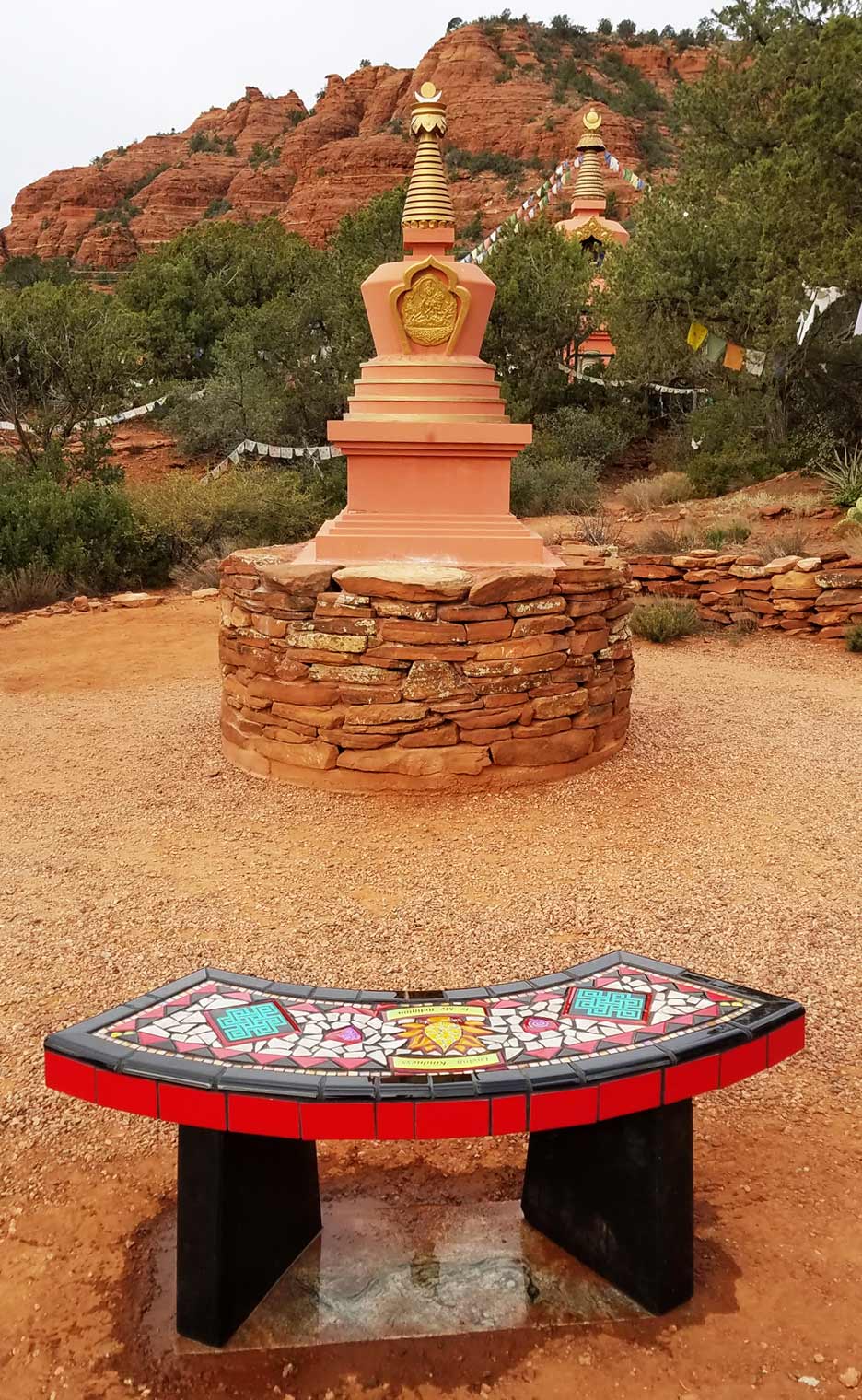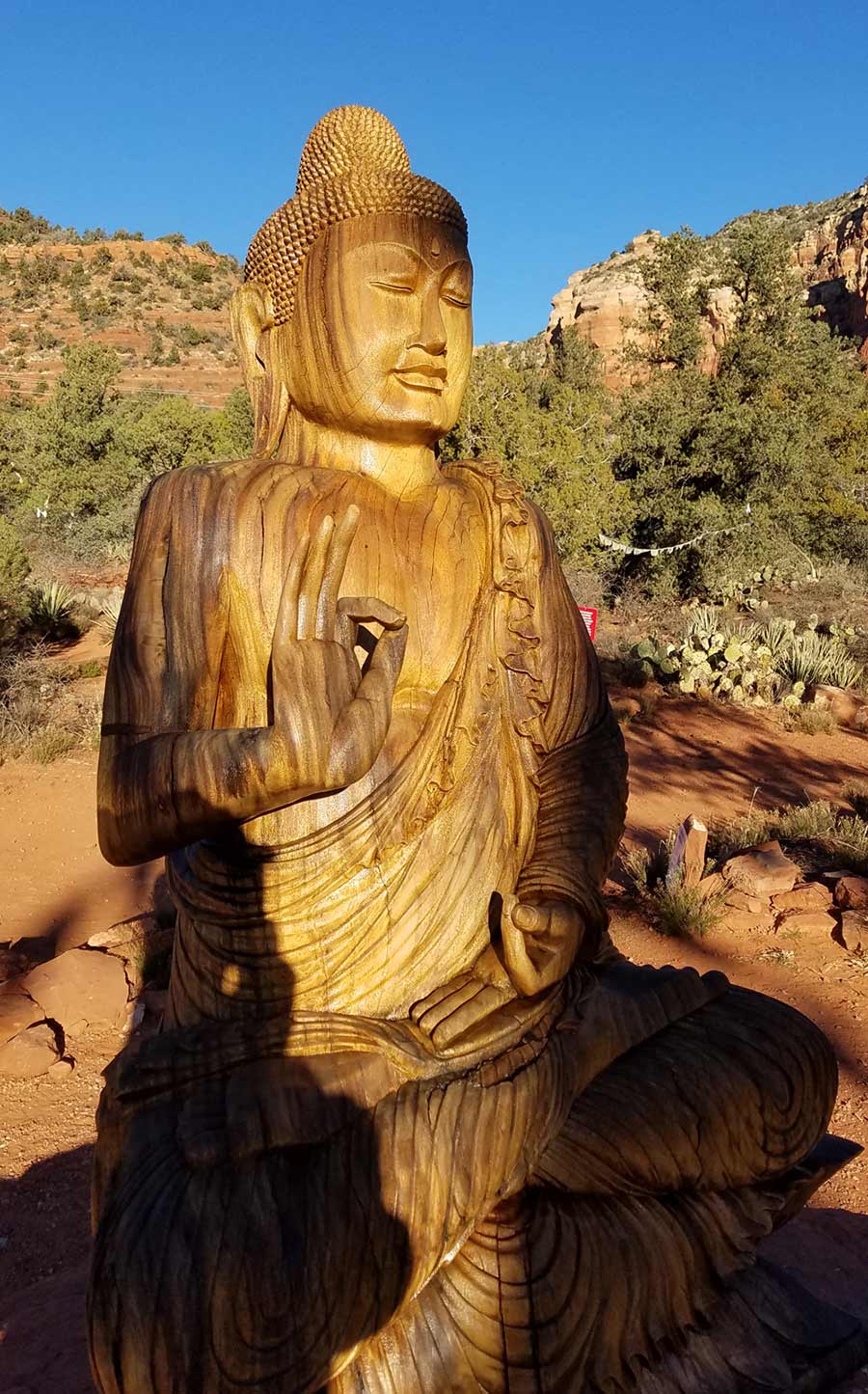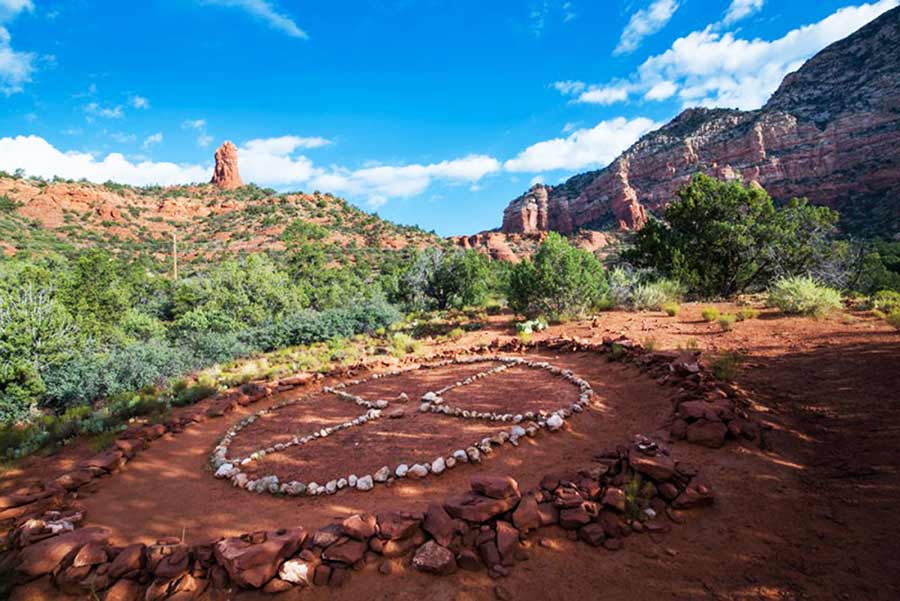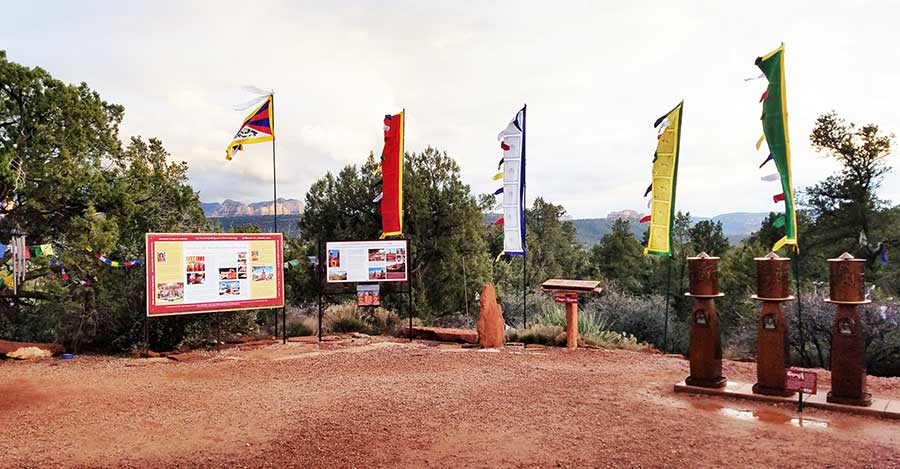Amitabha Stupa and Peace Park
KPC – Sedona Arizona

“You do not have to believe in Stupas just as you do not have to believe in the rain; it will come down naturally if there are the right conditions. So the benefit of the stupa happens quite naturally because of its structure and content. It is a manifestation of our true nature, beyond the confusion of words.” – Akong Tulku Rinpoche
KPC Arizona’s activity centers on the Amitabha Stupa and Peace Park in Sedona, Arizona. It is a beautiful outdoor venue and a spiritual destination for prayer, meditation, and the experience of peace in a sacred place. It was conceived of and built for people of all faiths.
The Amitabha Stupa and Peace Park came into being as a result of the vision of Jetsunma Ahkon Lhamo Rinpoche, Spiritual Director of Kunzang Palyul Chöling, a Buddhist organization committed to compassionate outreach. It has become a spiritual destination for prayer and meditation and a beloved place of peace and refuge for visitors from all over the world and residents of the Sedona area.
What to Know Before You Visit
The Amitabha Stupa truly is a living presence of peace and love. It is here in this world for the benefit of all sentient beings. It is here for you.
We highly recommend learning about the Amitabha Stupa before you visit.
Not only will learning about the Stupa deepen your experience while visiting, but you will understand how to properly use and respect this sacred place. The Amitabha Stupa and Peace Park is a destination for prayer, meditation, and the experience of peace in a sacred place. It is on private property owned by Kunzang Palyul Choling, a Tibetan Buddhist Temple in the Vajrayana Tradition. The park is open every day during daylight hours for people of all faiths. Visiting the Park is free and is supported by visitor donations.
Visiting the Amitabha Stupa and Peace Park

The Amitabha Stupa and Peace Park is open every day and visits are free of charge. It is supported solely by donations, which are gratefully received. There are two donation boxes on the property, one at the Amitabha Stupa and one close to the entrance.
The local KPC community holds Buddhist practices at the Amitabha Stupa and offers regular presentations about the 2500-year history and the profound spiritual benefits of stupas in general and the Amitabha Stupa in particular. Schedules change with the season and weather. You can visit the Stupa’s Facebook page to learn more, and keep abreast of practices, presentations, and other news. If you’d like to inscribe a brick along the path to peace at the Stupa, you can do so here.
What You Will Find When You Visit

What is a Stupa?
Buddhists refer to a consecrated stupa as a “Wish Fulfilling Jewel”. In this context a wish is the equivalent of a prayer. You can explain it as a spiritual generator or amplifier meaning that any prayers, meditations, visualizations and spiritual practices that are done at the stupa will be made more powerful by the spiritual energy that is imbued within it. That spiritual energy is derived from how the stupa came into being, its location, how it was built, and the profound offerings that are inside of it. It works for people of all faiths, including nonhuman beings.
A Short History of Stupas
Stupas came into being about 2600 years ago, during the time of Shakyamuni Buddha. Stupas are built according to very precise instructions that come directly from his teachings. Stupas are very common in the East where Buddhism has thrived for ages and quite new in the West. There are fewer than 100 stupas in the Western Hemisphere and 27 of them, including the two located in Sedona, have been built by Jetsunma Akhon Lhamo and her temple, Kunzang Palyul Choling.
On the Stupa property, you will find the 36-foot tall Amitabha Stupa,
About the Amitabha Stupa
All consecrated stupas come into being as the result of an enlightened vision of a recognized Buddhist master. The Amitabha Stupa came into being from the vision of Jetsunma Akhon Lhamo, a recognized reincarnate bodhisattva (Tulku) and lineage holder in the Nyingma tradition of Tibetan Buddhism. Jetsunma resided in Sedona for about 10 years and now lives at her main temple in Poolesville, Maryland, outside of Washington DC.
The Buddha Amitabha is a male deity and is often referred to as the Buddha of Limitless Light or the Buddha of Limitless Life. He is said to be the Buddha that will meet you at your time of passing to guide you to enlightenment. The Amitabha Stupa is considered to be an enlightenment stupa.
Building the Amitabha Stupa
Building the Amitabha Stupa took about 18 months and the vast majority of the work was performed by volunteers, many of whom came from around the world to participate in the project. The project was led by Tulku Sang-ngag Rinpoche, a Tibetan lama and master stupa builder, who followed the teachings of the Buddha in guiding the process.
Building the Amitabha Stupa was not an ordinary construction project, it was an act of devotion on the part of everyone who participated. Every day began and ended with spiritual practices and meditations, mantra (prayers) were recited throughout the day, and the workers all maintained a strict diet and code of behavior throughout the project.
The Inside Story of the Amitabha Stupa
Consecrated stupas like the Amitabha Stupa are hollow and filled with offerings from all over the world, all of which were blessed in elaborate ceremonies and rituals before they were put in the stupa and then again in the 3-day long consecration ceremony in August of 2004. Everything inside the stupa has to do with 3 things; the spread of compassion in the world, the end of suffering in the world, and your spiritual growth. For instance, there are hundreds of millions of prayers in the stupa, as well as 3600 handmade tsa-tsas or miniature stupas, offerings from every continent on earth, and many items intended as antidotes for various kinds of human suffering. Those include a large cache of food as an antidote to hunger, natural and traditional medicines as an antidote to illness, and most importantly, exceedingly rare relics from past Buddhas and enlightened masters dating back to the time of the Buddha.
“Stupas are filled with sacred images, mantras, and relics of holy beings. The foundation, symmetry, orientation and contents of the stupa create incredible power to those who even look upon it. Stupas have the power to transcend the limitations of language to achieve enlightened knowledge.” -Lama Zopa Rinpoche
If you are interested in knowing in depth what goes into a stupa, it’s symbolism, how it was activated, and take a deeper dive into the story of its miraculous construction, we highly recommend purchasing “The Story of the Amitabha Stupa”. You can flip through the book’s pages here.
Read The Story of the Amitabha Stupa
(Click the diagonal arrow icon below the flipbook viewing pane to enjoy a larger size of this beautiful book.)
Where can I buy the Amitbha Stupa book?
Go here to purchase your copy.
A Smaller Tara Stupa
The Tara Stupa, which sits about 100 feet east of the Amitabha Stupa was built in 1999. It has all the same qualities as the Amitabha Stupa and was built in the same way. The female deity Tara holds the mothering and compassionate energies of all the Buddhas and a Tara stupa is considered a long-life Stupa.
The Tara Stupa was dedicated to the long life and good health of the Venerable Gyaltrul Rinpoche whose temple and center are in Ashland Oregon. He was 73 years old at the time that the Tara Stupa was built (1999) and was in very poor health. He passed into parinirvana in April of 2023.
How to use a Stupa
Traditionally, stupa visitors prostrate, pray, meditate, make offering and walk around a stupa in a clockwise direction. The power of prayer is magnified at a stupa. Many people therefore recite mantras such as Om Mani Padme Hung (a prayer of compassion) while walking around. However, you can say or use your own prayers from whatever tradition or background you come from and connect with. A Stupas sole purpose for being in the world is to alleviate suffering, to move us forward on our spiritual path. It is said by honoring a stupa, we honor our own potential for enlightenment. The more we are focused on the benefit of others, the greater the blessings for ourselves and all sentient beings.
At the end of your visit, offer in your mind any virtue or positivity that was created by your visit to the end of suffering for others. You can say your own, or use Jetsunma Akhon Lhamo’s dedication prayer. This helps seal in the blessing.
“By this effort, may all sentient beings be free of suffering. May their minds be filled with the nectar of virtue. In this way, may all causes resulting in suffering be extinguished, and only the light of compassion shine throughout all realms.”
A Beautiful Mahogany Statue of Shakyamuni Buddha
The wooden statue above the Amitabha Stupa is a statue of Shakyamuni Buddha (also known as Siddhartha). It was a gift to the Stupa from a local gallery owner. The statue came from Bali, Indonesia and is carved out of a single piece of mahogany. (In case someone questions that, mahogany from Indonesia has a different appearance than mahogany we see in America, which comes from South America.)
An Authentic Native American Medicine Wheel
There is a Buddhist prophecy from the 7th century about the connection between the Tibetans and Native Americans. There is a matching prophecy in the Hopi tradition. The prophecies have come true and the medicine wheel honors that Tibetan-Native American connection.
Using the Medicine Wheel
The medicine wheel is available on a first come, first served basis for both private visitors and authorized tour guides and practitioners. No one has priority access over others.
If you encounter another group when you arrive, be kind and respectful and allow them to finish what they are doing.
If you are using the medicine wheel and others arrive, do not make the new group wait any longer than 15 minutes. Inform them of when you will be done and make every effort to accommodate them.
You cannot send people away from the medicine wheel because you are doing a private or secret ritual. The Medicine Wheel is for everyone. Find another location if you cannot share.
What are Prayer Flags?
Tibetan and Sanskrit writing is considered very sacred to Buddhists. So much so that as the wind moves across the letters, the prayer is sent out into space. The prayer flags you see hanging from the Stupa all have Buddhist prayers (mantra) printed on them. The wind is constantly blowing the blessings of those prayers across the land.
What do the five colors on the flags represent?
The five colors each relate to a corresponding element, afflictive emotion, and its antidote. Blue is space. Representing anger. Transformed it is mirror like wisdom. White is air. Represents the delusion of ignorance. Transformed it is the wisdom of reality, or dharmadhatu (basic space). Yellow is earth. Represents pride. Transformed it is the wisdom of equanimity. Green is water. Represents jealousy. Transformed it is all-accomplishing wisdom. Red is fire. Represents attachment or desire. Transformed it is the wisdom of discernment.
What are the Prayer Wheels?
There are about 2 million Buddhist mantras (Om Mani Padme Hung) inside each prayer wheel. The energy of spinning a prayer wheel (clockwise) while saying your own prayer sends those prayers and yours across the land. Prayer wheels are typically made of metal, wood, or cloth and contain a mantra written on paper, inscribed on metal plates, or embossed into an object.
Respecting the Land and the Stupas: some guidelines
The 14 acres located in Sedona Arizona that the Stupa is on is a wildlife sanctuary. Practice “Leave No Trace” and follow the guidelines you will find on the signs.
We ask that visitors do not climb on the Stupa or mark the Stupa in any way. Do not place anything on the Stupa itself. If you have an offering, please place it on the alter in front of the Stupa. Offerings are traditionally made at sacred sites to accumulate merit, or positive circumstances, and because of the transformative effect they have on our own mind through cultivating generosity.
We also ask that you be respectful of other visitors. Many people come to the Stupa to mediate and for peace, so please use quiet voices. Flutes and singing bowls are allowed, but not right at the Amitabha Stupa. Drumming is allowed only at the medicine wheel.
The meditation platform is reserved for meditation and prayer by individual visitors to the stupa and for Buddhist practices and activities led by the KPC Buddhist community.
Do not build or encourage the building of cairns and rock piles on the Stupa land.
The bowls of water on the altar represent pure offerings to the Buddha. They are filled every morning and emptied every evening by a volunteer. As the sign beside them says, it is not appropriate to put anything in the bowls, especially fingers.
Many people ask if the Stupa is a vortex. A Stupa is NOT a vortex. While there is certainly vortex energy on the Stupa land, it’s not correct to describe the Stupa as a vortex.
You’ll also find an abundance of walking trails, and informational signs that you will enjoy reading.
There are numerous quiet spots on the land for meditation and quiet conversation. What you will not find are picnic facilities and recreational activities (other than walking and hiking)
Tips for Amitabha Stupa Visitors

Wear good walking shoes, bring a hat and water to drink.
There is a porta-john available, close to the Amitabha Stupa.
Be mindful of those that are there for prayer and meditation. Please talk quietly and kindly silence your cell phone.
Practice the principles of “leave no trace”.
Pets on leashes are welcome. Please pick up after them.
Carry your trash back to the trash bin in the parking lot.
Drone photography or any unauthorized commercial video is prohibited
Do not decorate the property with your own statues, rock piles, or other items, except that prayer flags are allowed. Feel free to hang prayer flags in the trees around the property.
Directions, Group Visits, Stupa Presentations, and Handicapped Access

To arrange for group visits, a presentation to your group, or to make special arrangements for handicapped access, please call 877-788-7229 or email kpcsedona@tara.org well in advance.
Directions to the Amitabha Stupa
The Amitabha Stupa is located at 2650 Pueblo Drive in the heart of West Sedona.
Take state route 89A to Andante. Go North and turn left to 2650 Pueblo Drive in Sedona. You can also find us on Google or Apple Maps.
If the gate is open, turn immediately right onto the stupa land and proceed to one of the two parking areas. If the gate is not open, park on Pueblo Drive. The stupa is a five-minute walk from Pueblo on well-marked trails.
Please note – No Buses, RV’s, or other vehicles over 20′ in length are allowed on the property. The trails and parking cannot safely accommodate their size. KPC is not liable for any damage caused to, or by your vehicle. Thank you!
What are the Stupa and Parking Hours?
The Stupa is open from dawn to dusk every day. The parking lot is open 8:30 am till 5:00 pm seven days a week. Pedestrian traffic sunrise till sunset. Park closes at sunset. Please plan your trips to the stupa with that in mind. If you bring a group to the Stupa and do not expect to be done by the time the parking closes, please park on the street.
Access to the stupa property after dark is not allowed. We have a zero-tolerance policy on this.
More Questions?
Please contact us by email at kpcsedona@tara.org, or leave a voice mail at 877-788-7229.
Amitabha Stupa and Peace Park
PO Box 1142, Sedona, AZ 86339
Phone: 877-788-7229
See Map – Get Directions
Facebook


